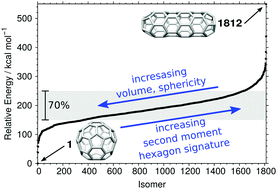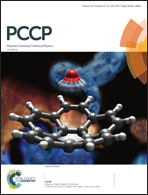Comprehensive theoretical study of all 1812 C60 isomers†
Abstract
We investigate all 1812 isomers of the fullerene C60 consistently with high-accuracy quantum chemistry methods. The isomers are optimized at the PBE-D3/def2-TZVP level of theory and their relative energies are obtained at the affordable and accurate hybrid-DFT level PW6B95-D3ATM/def2-QZVP. For the first time reliable values for the relative energy distribution among the 1812 isomers (maximum value of 549.1 kcal mol−1, average value of 189.8 ± 46.8 kcal mol−1, 1267 isomers in an energy window of 150–250 kcal mol−1) are given. The quality of the DFT energies is verified by comparison with highly accurate DLPNO-CCSD(T)/CBS* results for ten selected C60 isomers, and the DFT results are further used to benchmark several semiempirical methods. Our findings yield methodological insight into future multi-level modelling of larger carbon nano-structures. We correlate the best relative energies of the isomers to a number of topological indices, electronic properties, and geometrical measures in order to rationalize the isomeric stability aside from the common isolated pentagon rule minimizing the number of pentagon fusions. The information from the best qualitative measures can be condensed to the statement, that a small pentagon signature P1, a large volume, and a more spherical cage lead to a relatively stable isomer. In addition, the best semiempirical method was applied to all 31 924 isomers of C80.

- This article is part of the themed collection: 2017 PCCP HOT Articles


 Please wait while we load your content...
Please wait while we load your content...